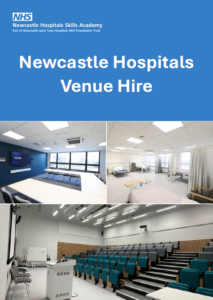The Royal Victoria Infirmary (RVI’s) Education Centre provides bespoke learning spaces for both clinical and non-clinical courses.
Furnished with the latest technology and equipment our first class facilities are designed to provide a range of ‘real life’ scenarios and situations in safe, replica clinical environments to ensure our delegates receive a high quality training experience.
These include state-of-the-art simulation facilities with ward bays, treatment rooms and even a replica operating theatre as well as a wide range of multiple purpose training rooms, a large lecture theatre and break out areas.
SIM Centre Clinical Room 1
Clinical room 1 is specially designed to be used as a ward environment and can easily house three beds. It is furnished with a nurse call system and oxygen points driven via medical air for safety. It also has:
- a digital patient whiteboard system
- two ceiling mounted cameras and one mobile camera
- four ceiling mounted microphones
Beds can be removed to allow for use as a flexible training space.

SIM Centre Clinical Room 2
Clinical room 2 is designed to be used as a theatre or recovery area and houses one bed with nurse call system and oxygen points driven via medical air for safety. It has:
- a digital patient whiteboard system
- two ceiling mounted cameras and one mobile camera
- four ceiling mounted microphones
Bed can be removed to allow for use as a flexible training space.

SIM training rooms 6 and 7
These two training rooms are separated by folding doors and so can be used as one large training room or separated into two smaller rooms.
Both rooms are supplied with computers and large display screens allowing for presentations and live streaming of simulation training sessions in real time, directly from the clinical rooms.

Control room
The Simulation Centre control room is situated between both clinical rooms and features two way mirrors so that technicians and faculty can oversee the simulation training.
Its position allows seamless streaming of the training, especially when the scenario involves the transfer of a patient from one clinical room to the other, e.g. from ward to theatre or theatre to recovery.
Our control room features:
- CamComms bespoke installation of audio-visual equipment
- Laerdal LLEAP System
- DECT phone system allowing for 2222 calls to be simulated
- Patient voice system
- cSkills debriefing system
- 2-way radio system for faculty prompts

How to find us
The RVI is close to Newcastle’s city centre on Queen Victoria Road. It can be easily accessed by public transport and there is public parking nearby if you are driving.
When planning your route to us please use postcode NE1 4LP.
Below are links to websites with helpful information on local public transport and other ways of getting to Newcastle.
Public Transport
Bus
The nearest bus interchanges are:
Further information about public transport can be found by:
- visiting the Nexus website
- calling Traveline 0871 200 2233
- using Google maps
Metro
The city centre is well served by the Tyne and Wear Metro with the nearest stations at:
Haymarket
Haymarket Metro Station is on the corner of Northumberland Street, St Mary’s Place and Percy Street.
The RVI is close to Newcastle University which you can see from St Mary’s Place.
You can walk through the University’s campus from Barras Bridge to reach Queen Victoria Road, or walk along Percy Street until you reach St Thomas’ Street and you will find the RVI in front of you when you reach Queen Victoria Road.
Click on the map below for the nearest bus stops for onward travel destinations.

Monument
Monument Metro Station is located at the top of Grey Street where it meets Blackett Street.
Turn left along Blackett Street and keep walking past the bus stops until you meet Percy Street. Keep walking along Percy Street until you reach St Thomas’ Street on your left.
You will find Queen Victoria Road at the top of St Thomas’ Street with the RVI in front of you.
Click on the map below for the nearest bus stops for onward travel destinations.

Cycling
Cycles are able to move freely across the Hospital Sites using the normal road infrastructure. There are links at site entrances and exits that link up with Newcastle City Council’s designated cycle routes and come from various directions across the city.
Park and Ride
Details of park and ride options in Newcastle are available here.
Driving to Newcastle
Newcastle is easily accessible if you are driving with major road routes straight to the centre from both the north (A1) and south (A1M) and from the west (A69).
High speed rail links
Newcastle is less than an hour and a half away from both Leeds and Edinburgh, and you can get here directly from London Kings Cross, Peterborough Birmingham, Sheffield, Manchester and Glasgow in just 3 hours or less and with a direct Metro from Newcastle Central Station to Monument Metro followed by a short walk to Eldon Court Education Centre.
Find out more information on times and fares at the LNER website.
Book a Room
There are a variety of rooms to hire at our educations centres perfect for hosting meetings, training days, lectures, conferences and more. Click below to see our venue brochure.

